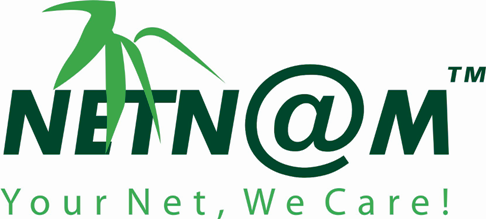Về nền tảng M$.
Đây là phần chú Biu M$
-
http://www.facebook.com/microsoftdeveloper
-
https://twitter.com/msdev
-
http://plus.google.com/111221966647232053570/
Only Microsoft brings you a complete set of innovative
platforms and technologies that help you shape the future. Whether you develop
for mobile, desktop, or the cloud–you are always playing in a single universe
of devices and services. It’s time to go exploring.
Chỉ M$ mới mang đến cho bạn một bộ hoàn chỉnh các nền tảng sáng tạo và công nghệ, giúp bạn định hình tương lai. Cho dù bạn phát triển phần mềm cho điện thoại di động, máy tính để bàn, hoặc điện toán đám mây – bạn luôn được chơi trong một thế giới các thiết bị và dịch vụ thống nhất. Hãy để chút thời gian khám phá…
(Chú Biu gáy to ghê)
Featured platforms and tools

Windows
Reach more people on more devices in 200 markets worldwide.
Visit the Dev Center
Discover the fastest-growing mobile OS on the market.
Need a cloud-based backend for your app? We’ve got you covered.
Develop productivity apps in their native environment—locally or in the cloud.

Xbox
Imagine your game on more than 76 million consoles worldwide.
Visit the Dev Center
Create a new breed of applications with these powerful tools.
Cloud and server
Discover the power and scalability of a Cloud OS.
Turning big data into big insights begins here.
From backup to backend, cloud database applications are changing business.
Extend your existing apps and connect cloud applications, mobile devices, and
external partners.
Business and enterprise
Apps that revolutionize work on the most popular collaboration platform in the
world.
146 billion e-mails are sent per day. How will you enable better communications?
Tomorrow’s workplace is anywhere you are. Add your vision to the future.
Resource planning is essential to companies and organizations. The only thing
missing is your idea.
More resources
Take a step:

Success stories
See how easy it is to develop with Microsoft—and how it pays off.
Watch now
Connect with tech advisors. Get some perspective. Attend an event.
Kick off your project with Microsoft’s development tools.
Ready to turn your game idea into reality?
Learning resources
Community
Support
Programs
ADM and the Zachman Framework
Introduction | The Zachman Framework | Mapping TOGAF to the Zachman Framework
This chapter provides a mapping of the TOGAF Architecture Development Method (ADM) to the Zachman Framework.
Introduction
A number of architecture frameworks exist, each of which has its particular advantages and disadvantages, and relevance, for enterprise architecture. Several are discussed in Other Architectures and Frameworks .
However, there is no accepted industry standard method for developing an enterprise architecture. The Open Group goal with TOGAF is to work towards making the TOGAF ADM just such an industry standard method, which can be used for developing the products associated with any recognized enterprise framework that the architect feels is appropriate for a particular architecture. The Open Group vision for TOGAF is as a vehicle and repository for practical, experience-based information on how to go about the process of enterprise architecture, providing a generic method with which specific sets of deliverables, specific reference models, and other relevant architectural assets can be integrated.
To illustrate the concept, this section provides a mapping of the various phases of the TOGAF ADM to the cells of the well-known Zachman Framework.
The Zachman Framework
The Zachman Framework for Enterprise Architecture, sometimes simply referred to as the “Zachman Framework”, has become a de facto standard for classifying the artifacts developed in enterprise architecture. It is a logical structure for classifying and organizing the design artifacts of an enterprise that are significant to its management. It draws on a classification scheme found in the more mature disciplines of architecture/construction and engineering/manufacturing, used for classifying and organizing the design artefacts relating to complex physical products such as a building or an aircraft. Zachman adopts this classification scheme to the design and construction of information systems.
The Zachman Framework comprises a 6×6 matrix.
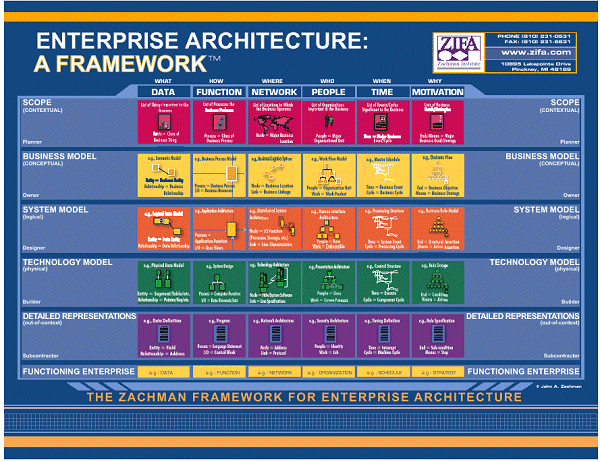
The columns represent various aspects of the enterprise that can be described or modeled; and the rows represent various viewpoints from which the aspects can be described. Thus each cell formed by the intersection of a column and a row represents an aspect of the enterprise modeled from a particular viewpoint. The architect selects and models the cells that are appropriate to the immediate purpose, with the ultimate objective of modeling all the cells.
The six viewpoints are:
- The Scope (Contextual) viewpoint – aimed at the planner
- The Business Model (Conceptual) viewpoint – aimed at the owner
- The System (Logical) viewpoint – aimed at the designer
- The Technology (Physical) viewpoint – aimed at the builder
- The Detailed Representations (Out-of-Context) viewpoint – aimed at the subcontractor
- The Functioning Enterprise viewpoint
The six aspects – and the interrogatives to which they correspond – are:
- The Data aspect – What?
- The Function aspect – How?
- The Network aspect – Where?
- The People aspect – Who?
- The Time aspect – When?
- The Motivation aspect – Why?
Although the Zachman Framework applies to enterprises, the Framework itself is generic. It is a comprehensive, logical structure for the descriptive representations (i.e., models or design artefacts) of any complex object, and it does not prescribe or describe any particular method, representation technique, or automated tool.
The strength of the Framework is that it provides a way of thinking about an enterprise in an organized way, so that it can be described and analyzed. It also enables the individuals involved in producing enterprise information systems to focus on selected aspects of the system without losing sight of the overall enterprise context. In designing and building complex systems, such as enterprise systems, there are simply too many details and relationships to consider simultaneously. At the same time, isolating single variables and making design decisions out of context results in sub-optimization, with all the attendant costs and risks. The challenge is the same whether the system is physical (like an aircraft) or conceptual (like an enterprise system). How do you design and build it, piece by piece, and step by step, such that it achieves its purpose without losing its value and raising its cost by optimizing the pieces and sub-optimizing the overall?
Mapping TOGAF to the Zachman Framework
The scope of the four architecture domains of TOGAF align very well with the first four rows of the Zachman Framework, as shown in the following mapping of these domains.
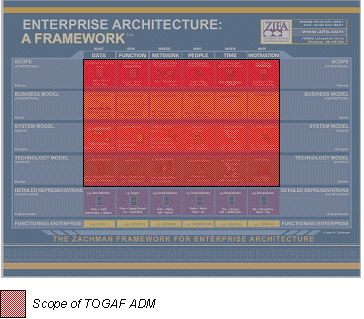
Several domains overlap in the above diagram: the earliest domain to address a cell has precedence in the coloring scheme.
The mappings of the individual phases of the ADM are shown in detail below.
- Note:
- In addition to the mappings to specific cells given below, the detailed representations and functioning enterprise viewpoints (the lowest two rows) of the Zachman Framework are also addressed and represented in TOGAF, through the Architecture Governance Framework (see Architecture Governance Framework), and through ADM deliverables such as the various Architecture Contracts (see Architecture Contracts). These ensure the validity and viability of the delivered solutions to meet the business needs.
Preliminary Phase: Framework and Principles
The outputs of this phase are:
- Framework DefinitionZF: Business/Function (model of the architecture development process)
[R2,C2] - Architecture principlesZF: Scope/Data, Scope/Function, Scope/Network, Scope/People, Scope/Time, Scope/Motivation
[R1,C1; R1,C2; R1,C3; R1,C4; R1,C5; R1,C6] - Restatement of, or reference to, business principles, business goals, and business driversZF: Composite of: Scope/Motivation, Business/Motivation
[R1,C6; R2,C6]
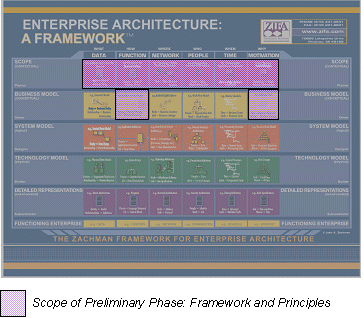
Phase A: Architecture Vision
The outputs of this phase are:
- Approved Statement of Architecture Work, including in particular:
- Scope and constraintsZF: Scope/Data, Scope/Function, Scope/Network, Scope/People, Scope/Time
[R1,C1; R1,C2; R1,C3; R1,C4; R1,C5; R1,C6]- Note:
- The Scope/Motivation cell is presumed to be addressed by strategic business planning activities outside the scope of the Architecture Vision.
- Plan for the architecture work
- Scope and constraintsZF: Scope/Data, Scope/Function, Scope/Network, Scope/People, Scope/Time
- Refined statements of business principles, business goals, and strategic driversZF: Scope/Data, Scope/Motivation
[R1,C1; R1,C6] - Architecture principles (if not previously existing)ZF: Scope/Data, Scope/Function, Scope/Network, Scope/People, Scope/Time, Scope/Motivation
[R1,C1; R1,C2; R1,C3; R1,C4; R1,C5; R1,C6] - Architecture Vision/Business Scenario, including:
- Baseline Business Architecture, Version 0.1ZF: Business/Data, Business/Function, Business/Network, Business/People, Business/Time, Business/Motivation
[R2,C2; R2,C2; R2,C3; R2,C4; R2,C5; R2,C6] - Baseline Technology Architecture, Version 0.1ZF: System/Data, System/Function, System/Network, System/People, System/Time, System/Motivation
[R3,C2; R3,C2; R3,C3; R3,C4; R3,C5; R3,C6] - Target Business Architecture, Version 0.1ZF: Business/Data, Business/Function, Business/Network, Business/People, Business/Time, Business/Motivation
[R2,C2; R2,C2; R2,C3; R2,C4; R2,C5; R2,C6] - Target Technology Architecture, Version 0.1ZF: System/Data, System/Function, System/Network, System/People, System/Time, System/Motivation
[R3,C2; R3,C2; R3,C3; R3,C4; R3,C5; R3,C6]
- Baseline Business Architecture, Version 0.1ZF: Business/Data, Business/Function, Business/Network, Business/People, Business/Time, Business/Motivation
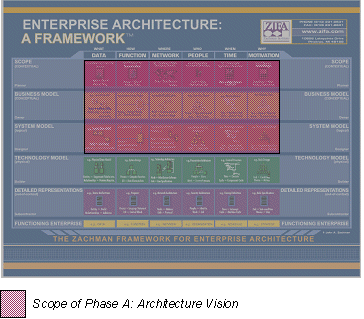
Phase B: Business Architecture
The outputs of this phase are:
- Statement of Architecture Work (updated if necessary)
- Validated business principles, business goals, and strategic driversZF: Scope/Data, Scope/Function, Scope/Network, Scope/People, Scope/Time
[R1,C1; R1,C2; R1,C3; R1,C4; R1,C5; R1,C6] - Target Business Architecture, Version 1.0 (detailed)
- Organization structure, identifying business locations and relating them to organizational unitsZF: Scope/Network, Scope/People, Business/Network, Business/People
[R1,C3; R1,C4; R2,C3; R2,C4] - Business goals and objectives, for each organizational unitZF: Scope/Network, Scope/Time, Business/Network, Business/Time, Business/Motivation
[R1,C3; R1,C5; R2,C3; R2,C5; R2,C6]- Note:
- The Scope/Motivation cell is presumed to be addressed by strategic business planning activities outside the scope of the Business Architecture.
- Business functions – a detailed, recursive step involving successive decomposition of major functional areas into sub-functionsZF: Scope/Function, Business/Function
[R1,C2; R2,C2] - Business services – the services that each enterprise unit provides to its customers, both internally and externallyZF: Business/Function, System/Function
[R2,C2; R3,C2] - Business processes, including measures and deliverablesZF: Business/Function, Business/Time
[R2,C2; R2,C5] - Business roles, including development and modification of skills requirementsZF: Scope/People, Business/People
[R1,C4; R2,C4] - Correlation of organization and functions; relate business functions to organizational units in the form of a matrix reportZF: Scope/Function, Scope/Network, Scope/People, Business/Function, Business/Network, Business/People
[R1,C2; R1,C3; R1,C4; R2,C2; R2,C3; R2,C4]
- Organization structure, identifying business locations and relating them to organizational unitsZF: Scope/Network, Scope/People, Business/Network, Business/People
- Baseline Business Architecture, Version 1.0 (detailed), if appropriate
- Views corresponding to the selected viewpoints addressing key stakeholder concerns
- Gap analysis results
- Technical requirements (drivers for the Technology Architecture work): identifying, categorizing, and prioritizing the implications for work in the remaining architecture domains; for example, by a dependency/priority matrix (e.g., guiding trade-off between speed of transaction processing and security); list the specific models that are expected to be produced (e.g., expressed as primitives of the Zachman Framework)ZF: System/Motivation
[R3,C6] - Business Architecture Report
- Updated business requirements
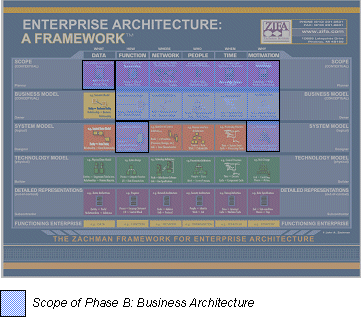
- Note:
- The Business/Data cell is covered by the Data and Applications Architectures.
Phase C: Informations System Architectures: Data Architecture
The outputs of this part of Phase C are:
- Statement of Architecture Work (updated if necessary)
- Baseline Data Architecture, Version 1.0, if appropriate
- Validated principles, or new data principles (if generated here)ZF: Scope/Data, Scope/Network, Scope/People, Scope/Time
[R1,C3; R1,C4; R1,C5] - Target Data Architecture, Version 1.0:
- Business data modelZF: Business/Data
[R2,C1] - Logical data modelZF: System/Data
[R3,C1] - Data management process modelsZF: System/Function, System/People
[R3,C2; R3,C3] - Data entity/business function matrixZF: Composite of Business/People, System/Data, System/Function
[R2,C4; R3,C1; R3,C2] - Data interoperability requirementsZF: Composite of System/Data, System/Function, System/Network, System/People
[R3,C1; R3,C2; R3,C3; R3,C4]
- Business data modelZF: Business/Data
- Viewpoints addressing key stakeholder concerns
- Views corresponding to the selected viewpoints; for example:
- Data dissemination viewZF: Composite of System/Data, System/Function, System/Network, System/People
[R3,C1; R3,C2; R3,C3; R3,C4] - Data lifecycle viewZF: Composite of System/Data, System/Function, System/Time
- Data security viewZF: Composite of System/Function, System/Data, System/Network, System/People, System/Time
- Data model management viewZF: Composite of Business/Data, System/Data, Business/Time, System/Time
- Data dissemination viewZF: Composite of System/Data, System/Function, System/Network, System/People
- Gap analysis results
- Relevant technical requirements that will apply to this evolution of the architecture development cycleZF: System/Motivation
- Data Architecture Report, summarizing what was done and the key findings
- Impact Analysis
- Updated business requirements, if appropriate
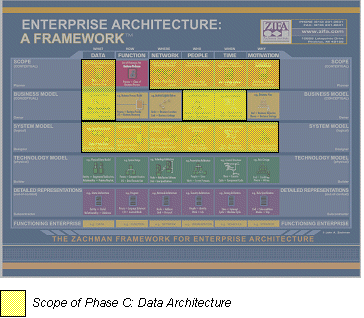
Phase C: Informations System Architectures: Applications Architecture
The outputs of this part of Phase C are:
- Statement of Architecture Work (updated if necessary)
- Baseline Applications Architecture, Version 1.0, if appropriate
- Validated application principles, or new application principles (if generated here)ZF: Scope/Function, Scope/Network, Scope/People, Scope/Time
- Target Applications Architecture, Version 1.0:
- Process systems modelZF: System/Function
- Systems/place modelZF: System/Network
- People/systems modelZF: System/People
- Systems/time modelZF: System/Time
- Applications interoperability requirementsZF: Composite of System/Data, System/Function, System/Network, System/People, System/Time, System/Motivation
- Viewpoints addressing key stakeholder concerns
- Views corresponding to the selected viewpoints; for example:
- Common applications services viewZF: Composite of System/Data, System/Function, System/Network, System/People, System/Time
- Applications interoperability viewZF: Composite of System/Data, System/Function, System/Network, System/Time
- Applications/information viewZF: Composite of System/Data, System/Function, System/Network, System/Time
- Applications/user locations viewZF: Composite of System/Network, System/People
- Gap analysis results
- Areas where the Business Architecture may need to change to cater for changes in the Applications ArchitectureZF: Composite of Business/Data, Business/Function, Business/Network, Business/People, Business/Time
- Identify any areas where the Data Architecture (if generated at this point) may need to change to cater for changes in the Applications ArchitectureZF: Composite of Business/Data, Business/People, Business/Time
- Identify any constraints on the Technology Architecture about to be designedZF: System/Motivation
- Applications Architecture Report, summarizing what was done and the key findings
- Impact Analysis
- Updated business requirements, if appropriate
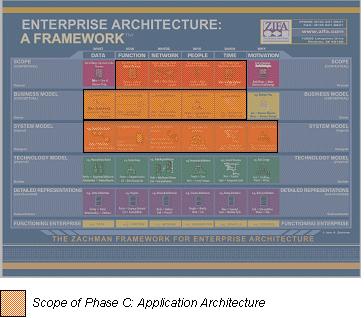
Phase D: Technology Architecture
The outputs of Phase D are given below, first by relevant individual step, and then as a composite for the whole phase.
Step 1: Create a Baseline Description in the TOGAF Format
The outputs of this step are:
- Technology Architecture principles (if not existing)ZF: Scope/Data, Scope/Function, Scope/Network, Scope/People, Scope/Time, Scope/Motivation
- Target Technology Architecture, Version 0.2:
- Technology Architecture – Constraints
- Technology Architecture – Architecture Principles
- Technology Architecture – Requirements Traceability, key questions list
- Technology Architecture – Requirements Traceability, criteria for selection of service portfolio
- Technology Architecture Model, Version 0.1ZF: Technology/Function, Technology/Network
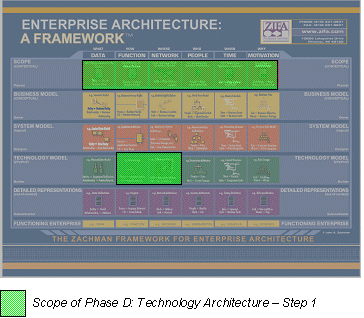
Step 2: Consider Different Architecture Reference Models, Viewpoints, and Tools
The outputs of this step are:
- Target Technology Architecture, Version 0.3
- Technology Architecture – Architecture Viewpoints
- Networked computing/hardware viewZF: System/Network, Technology/Network
- Communications viewZF: Composite of: System/Network, System/People, Technology/Network, Technology/People
- Processing viewZF: System/Data, System/Function, System/Network, System/People, System/Time, Technology/Data, Technology/Function, Technology/Network, Technology/People, Technology/Time
- Cost viewZF: Technology/Motivation
- Standards viewZF: Technology/Motivation
- Technology Architecture – ConstraintsZF: System/Motivation
- Technology Architecture – Architecture Viewpoints
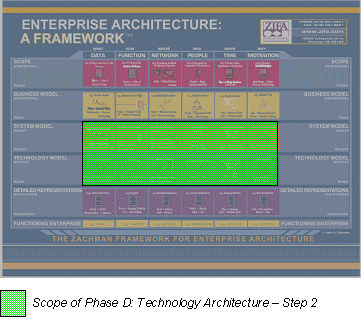
Step 3: Create an Architectural Model of Building Blocks
The outputs of this step are:
- Target Technology Architecture, Version 0.4
- Technology Architecture Model
- Networked computing/hardware viewZF: Technology/Network, System/Network
- Communications viewZF: Composite of: Technology/Network, Technology/People, System/Network, System/People
- Processing viewZF: Technology/Network, Technology/Time, Technology/People, Technology/Data, Technology/Function, System/Network, System/Time, System/People, System/Data, System/Function
- Cost viewZF: Technology/Motivation
- Standards viewZF: Technology/Motivation
- Technology Architecture – change requests and/or extensions or amendments to be incorporated in an organization-specific Architecture Continuum
- Technology Architecture Model
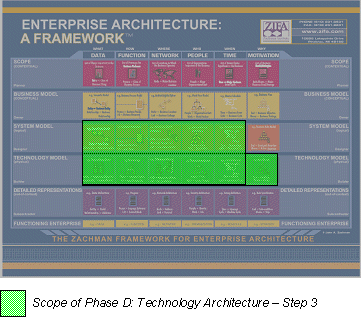
Step 4: Select the Services Portfolio Required per Building Block
The outputs of this step are:
- Target Technology Architecture, Version 0.5
- Technology Architecture – target services (a description of the service portfolios required also known as an Organization-Specific Framework)ZF: Technology/Network, Technology/Time, Technology/People, Technology/Data, Technology/Function, Technology/Motivation
- Technology Architecture – change requests and/or extensions or amendments to be incorporated in an organization-specific Architecture Continuum
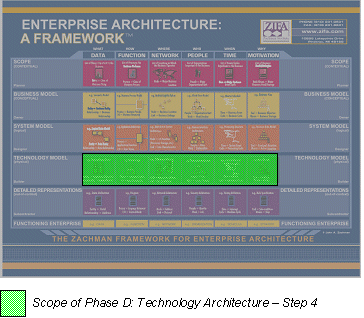
Step 8: Conduct a Gap Analysis
The outputs of this step are:
- Target Technology Architecture, Version 1.0:
- Technology Architecture – gap reportZF: Composite of Technology/Data, Technology/ Function, Technology/Network, Technology/People, Technology/Time, Technology/Motivation
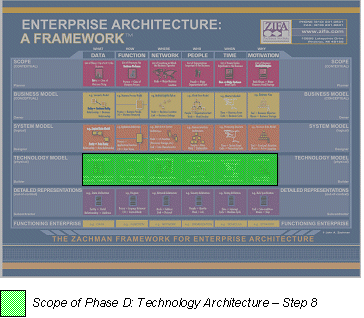
Composite Mapping for Phase D
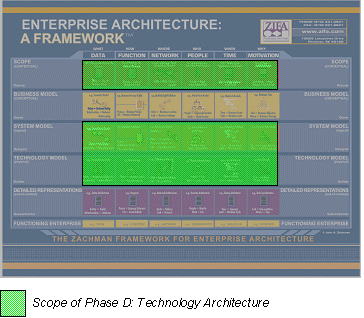
For more detailed information on the Zachman Framework, refer to any of John Zachman’s publications, or the Zachman Institute for Framework Advancement (ZIFA) (www.zifa.com).
return to top of page
The TOGAF document set is designed for use with frames. To navigate around the document:
- In the main Contents frame at the top of the page, click the relevant hyperlink (Part I, Part II, etc.) to load the Contents List for that Part of the TOGAF document into the Secondary Index frame in the left margin.
- Then click in that Contents List to load a page into this main frame.
Downloads
Downloads of the TOGAF documentation, are available under license from the TOGAF information web site. The license is free to any organization wishing to use TOGAF entirely for internal purposes (for example, to develop an information system architecture for use within that organization). A hardcopy book is also available from The Open Group Bookstore as document G063.















